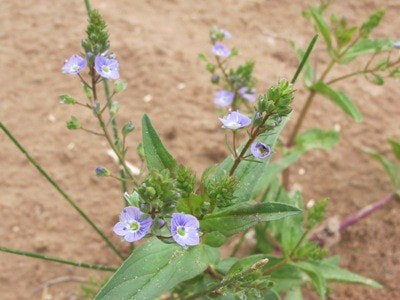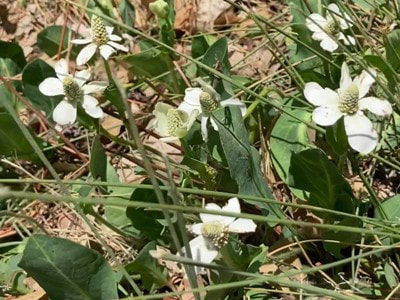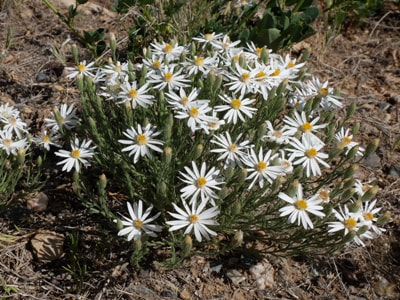Water Hemlock, Spotted Cowbane, Beaver Poison,Cicuta maculate,Parsley/Carrot Family (Apiaceae)6/26/2020 Found in wet soil, marshes, ditches
Seen blooming in June by the Rio Chama This is a Public Service Announcement! Do not touch any part of this plant because it is the “most violently toxic plant in North America” according to the USDA Agricultural Research Service. It is very similar in appearance to other members of the Parsley/Carrot family, some of which are edible or medicinal, so avoid all unless you are an expert. It grows from two to seven feet tall with stout, hollow stems. Leaves are divided into toothed, lance-shaped leaflets. Distinguishing features of the Water Hemlock are the prominent veins in the leaflets that end in the notches between the teeth and the purplish spots at the base of the stem where it meets the ground. Flower clusters of tiny, white flowers are 3" to 6" across. All parts of the plant are toxic, particularly the root. Browsing livestock can easily pull a root from the soil when browsing new green growth. A single section of root can kill a cow, hence the common name of Cowbane. Despite its toxicity it was used by Native Americans as an insecticide, for sterility if ingested, ceremonially, to help with broken bones and bruises, and as a poison for hunting. Source. If you trying to identify a different flower then you can check what other flowers bloom this month. If you cannot identify a flower from the website send a photo and where you took it to [email protected]. Read online for tips.
0 Comments
Found in shallow water, moist areas, stream sides
Seen blooming in June by the Rio Chama Although common along local waterways Water Speedwell is hard to spot because of its small flowers. It usually grows sprawling to two feet with erect flower stems growing from the base of the leaves and the end of the branches. Leaves have small teeth, clasp the stem and are up to three inches long. Tiny flowers are ¼ inch across and grow in clusters of 30 or more flowers. The flowers have four lavender blue or violet petals with purple lines and two long stamens. Leaves are edible raw or cooked and are rich in vitamin C. They have a subtle flavor and can be added to salads or used as a potherb. When used in salads they go better with a lemon dressing than vinegar. The root and the leaves are used medicinally to improve appetite, as a blood tonic, to improve urine flow, in the treatment of scurvy, and to treat burns and skin ulcers. Source. If you trying to identify a different flower then you can check what other flowers bloom this month. If you cannot identify a flower from the website send a photo and where you took it to [email protected]. Read online for tips. Yerba Mansa, Lizard's Tail, Yerba del Manso,Anemopsis Californica,Lizard Tail Family (Saururaceae)6/12/2020 Found in wet alkaline or saline soil
Seen blooming in June by CR 56 in Ohkay Owingeh Yerba Mansa grows to 12 inches high with waxy, mostly basal leaves which form a dense ground cover. Flower heads are a fragrant, showy, cone-shaped spike over one inch long surrounded by four to nine white to reddish petal-like bracts. The spike consists of about 100 densely packed greenish flowers which have a small white bract but no petals. In the fall, the whole plant turns brick-red in color. Yerba Mansa is an important medicine plant used as a disinfectant, anti-bacterial, anti-fungal and a general anti-microbial. It is used as a treatment for wounds, cold and flu symptoms, pain and inflammation, as well as lung, circulatory, urinary, and digestive tract ailments. Tea made from the leaves and roots is used to treat uterine cancer, ease menstrual cramps, induce conception, staunch excessive bleeding after childbirth and as a treatment for other gynecological conditions, and to treat venereal sores and ulcers. Source. If you trying to identify a different flower then you can check what other flowers bloom this month. If you cannot identify a flower from the website send a photo and where you took it to [email protected]. Read online for tips. Rose Heath, Baby White, Baby Aster, Sand Aster,Chaetopappa ericoides,Sunflower Family (Asteraceae)6/3/2020 Found in dry open areas, roadsides
Seen blooming in June by the road to Abiquiu Lake The Rose Heath is neither a rose nor a heath. Its dainty white flowers look like daisies but are not daisies, although in the same family. It grows in groups of plants to 6 inches high with many slender stems, often forming a compact mound. The simple narrow leaves are heath-like and hairy. Its petals curl under in the evening and after rain. Native Americans found a variety of medicinal uses for the petite Rose Heath. The Havasupai used it as a gastrointestinal aid, the Hopi used it to aid ‘a sore nose’, as a panacea, a sedative, a stimulant and for determining the sex of a baby, the Navajo used it for kidney and bladder disease, and as a toothache and snakebite remedy and the Zuni used it as a cold remedy and for swelling and rheumatic pain. Source. If you trying to identify a different flower then you can check what other flowers bloom this month. If you cannot identify a flower from the website send a photo and where you took it to [email protected]. Read online for tips. |
AuthorI am Marilyn Phillips, a native of England, whose love of nature and the outdoors from childhood brought me by a circuitous route to Crested Butte, Colorado in 1993 and 16 years later to northern New Mexico. My exploration of the many trails in these areas, my interest in wildflowers and photography, and career in computer system design came together in this creation. If you have any corrections, comments or questions, please contact me by email. Archives
September 2025
Categoriescopyright © 2020
|






 RSS Feed
RSS Feed